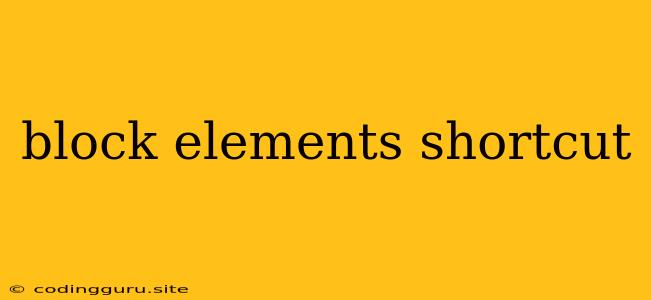Mastering Block Elements: Shortcuts for Efficient Web Development
Are you tired of constantly typing out long HTML tags for block elements? Do you wish there was a quicker way to add elements like <div>, <p>, and <ul> to your code? Fear not, web developers! There are powerful shortcuts at your fingertips that can dramatically speed up your coding process.
What are Block Elements?
Before we dive into shortcuts, let's clarify what block elements are. In basic terms, block elements occupy the entire width of their container and start on a new line. Common examples include:
<div>- The most versatile block element, used for grouping content.<p>- Used for paragraphs of text.<ul>- Used for unordered lists.<ol>- Used for ordered lists.<h1>- Used for headings (level 1).
The Power of Shortcuts
Shortcuts can be your secret weapon for efficient web development. Here are some popular shortcuts to boost your coding speed:
1. Emmet: The Ultimate Shortcut Engine
Emmet is an abbreviation-based syntax that drastically simplifies HTML and CSS writing. It's often built into popular code editors like Visual Studio Code and Sublime Text. Here's how it works:
Example:
To create a <div> element with the class "container" and a paragraph element inside:
div.container>p
Press Tab and Emmet expands this into:
2. Auto-Complete: Let Your Editor Do the Heavy Lifting
Most code editors have built-in auto-complete features. Start typing an HTML tag, and your editor will suggest possible completions. This saves you time by avoiding repetitive typing.
Example:
Type <di and your editor might suggest <div>, <dialog>, or other related tags.
3. Snippet Libraries: Pre-Built Code Snippets
Snippet libraries provide ready-made code snippets that you can insert directly into your project. This eliminates the need to write common code blocks from scratch.
Example:
You can find pre-built snippets for forms, tables, and other common HTML elements.
4. Keyboard Shortcuts for Common Actions
Mastering keyboard shortcuts can make your development workflow much faster:
- Ctrl+Shift+L (Windows/Linux) or Cmd+Shift+L (macOS): Select all occurrences of a word or phrase.
- Ctrl+D (Windows/Linux) or Cmd+D (macOS): Select the next occurrence of the current selection.
- Ctrl+X (Windows/Linux) or Cmd+X (macOS): Cut the current selection.
- Ctrl+C (Windows/Linux) or Cmd+C (macOS): Copy the current selection.
- Ctrl+V (Windows/Linux) or Cmd+V (macOS): Paste the copied content.
Tips for Mastering Shortcuts
- Start with the basics: Focus on learning the most common shortcuts for your daily workflow.
- Practice regularly: The more you use shortcuts, the more intuitive they become.
- Customize your shortcuts: Many code editors allow you to customize shortcuts to suit your preferences.
- Explore online resources: There are numerous online resources with comprehensive shortcut lists for different code editors.
The Importance of Efficiency
Efficiency in web development is key. Mastering block elements shortcuts allows you to:
- Reduce repetitive typing: Focus on the creative aspects of web development rather than tedious typing.
- Save time: Complete tasks faster and meet deadlines more effectively.
- Improve code quality: Shortcuts often generate well-formatted and standardized code.
Conclusion
By leveraging powerful block elements shortcuts, you can significantly enhance your web development speed and efficiency. Emmet, auto-complete, snippet libraries, and keyboard shortcuts are your allies in creating beautiful and functional websites with ease. Remember, the journey to becoming a more efficient web developer starts with a few simple shortcuts.
